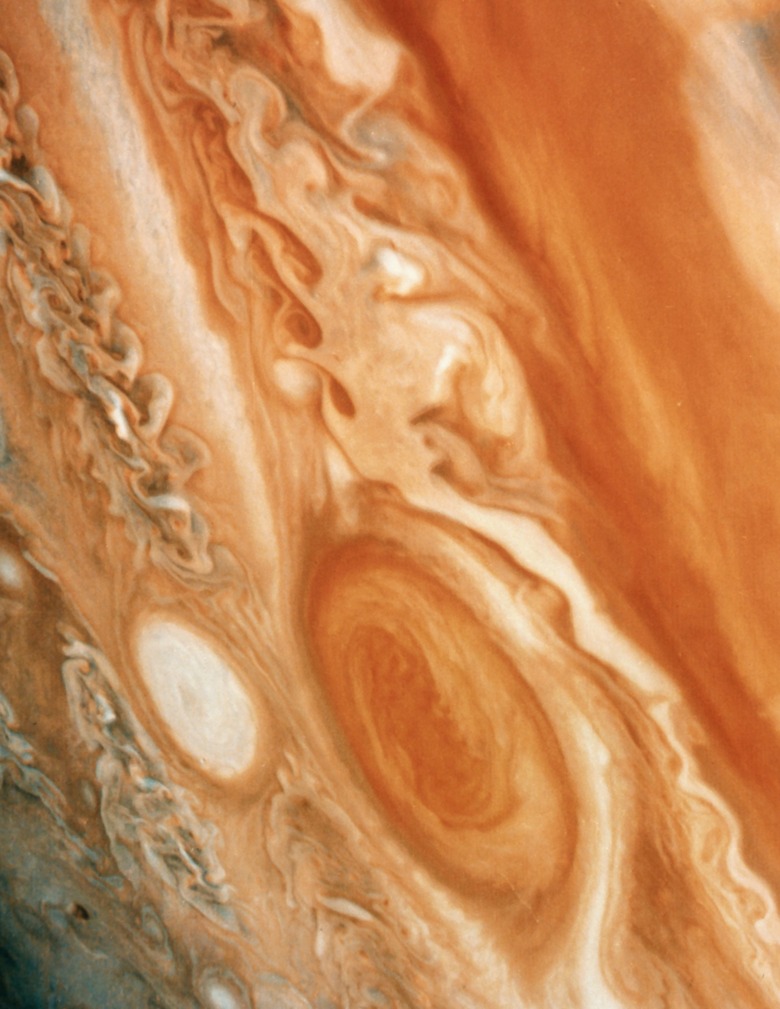Which Planet Has Permanent Storms?
One of the most distinctive features in the solar system is the Great Red Spot of Jupiter. A giant storm that swirls through the atmosphere of the planet, it was first observed by astronomer Jean-Dominique Cassini in 1655 and has been raging continuously ever since. However, imaging from the Pioneer, Cassini and Galileo spacecraft, as well as the Hubble telescope, has shown scientists that the GRS is not the only storm out there.
Jupiter's Giant Storm
Jupiter's Giant Storm
Scientists believe that Jupiter's Great Red Spot predates Cassini's first observation of it, and no one knows how long it will last. In 2013, it was about the size of three Earth diameters, but in 1913 it was approximately twice as large. Scientists don't know whether it shrinks and grows cyclically or whether it is gradually disappearing. Infrared imaging suggests that the spot is approximately 8 kilometers (5 miles) above the surrounding clouds and colder. Wind speeds inside the storm are low, but on the periphery, they gust to 432 kilometers per hour (268 miles per hour).
Red Spot Characteristics
Red Spot Characteristics
The Great Red Spot isn't always red. Its hue varies from brick to salmon to white, and at times it disappears from the visible spectrum, leaving a hole known as the Red Spot Hollow in the Southern Equatorial Belt, or SEB, of the planet. Scientists don't know what causes the color variations, but popular theories suggest that material gets dredged from lower in the atmosphere and turns red when struck by solar ultraviolet rays. The color of the spot seems to be tied to the color of the SEB. When the spot is dark, the SEB is whitish, and vice versa. These colors change frequently and unpredictably.
Red Spot Junior
Red Spot Junior
In 2000, astronomers observed the collision of three small storms on Jupiter that merged to form a single storm that became known as Oval BA. In 2005, the color of the storm changed from white to brown and finally to red, until it was the same color as the GRS. The fact that it turned red is confirmation to some planetary scientists that the color is the result of the storm dredging up material from lower in the atmosphere, and it may mean that the storm is intensifying. If so, it may reach the same size as the GRS and give scientists clues about the origins of that enigmatic storm.
Storms on Other Planets
Storms on Other Planets
Neptune, the eighth planet in the solar system, has a surface feature called the Great Dark Spot. It is about the size of the Earth and bears similarities to Jupiter's Great Red Spot, including the fact that it rotates counterclockwise. Scientists believe it is the product of the temperature differential between the planet's warm core and its cold cloud tops, and it features the fastest winds in the solar system. Meanwhile, a powerful storm system arose on Saturn in 2011 and engulfed a large portion of its northern hemisphere. Observed by the Cassini spacecraft and ground-based telescopes, the system had begun to fade by late 2012.
Cite This Article
MLA
Deziel, Chris. "Which Planet Has Permanent Storms?" sciencing.com, https://www.sciencing.com/planet-permanent-storms-3652/. 24 April 2017.
APA
Deziel, Chris. (2017, April 24). Which Planet Has Permanent Storms?. sciencing.com. Retrieved from https://www.sciencing.com/planet-permanent-storms-3652/
Chicago
Deziel, Chris. Which Planet Has Permanent Storms? last modified August 30, 2022. https://www.sciencing.com/planet-permanent-storms-3652/
